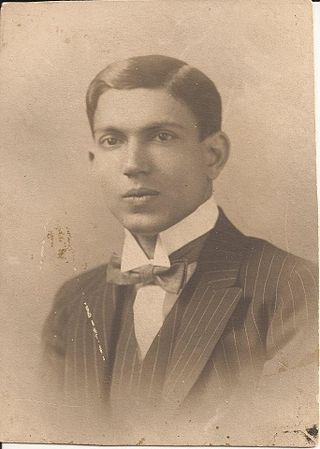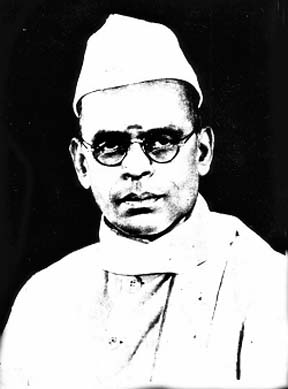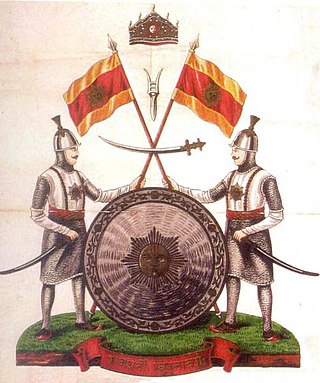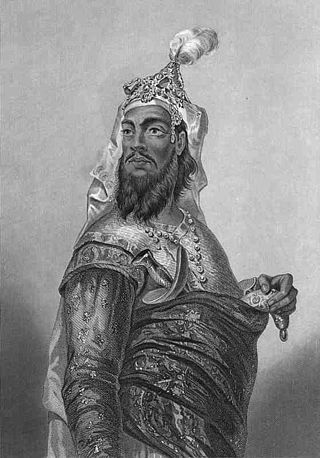
Jayaprakash Narayan Srivastava, also known as JP and Lok Nayak, was an Indian independence activist, theorist, socialist and political leader. He is mainly remembered for leading the mid-1970s opposition against Prime Minister Indira Gandhi and calling for her overthrow in a "total revolution". In 1999, Narayan was posthumously awarded the Bharat Ratna, India's highest civilian award, in recognition of his social service. His other awards include the Magsaysay award for public service in 1965.

Ludhiana is the most populous and the largest city in the Indian state of Punjab. The city has an estimated population of 1,618,879 as of the 2011 census and distributed over 310 km2 (120 sq mi), making Ludhiana the most densely populated urban centre in the state. It is a major industrial center of Northern India, referred to as "India's Manchester" by the BBC. It is also known as the commercial capital of Punjab.

Keshav Baliram Hedgewar, also known by his moniker Doctorji, was an Indian political-social activist, physician and the founder of the Rashtriya Swayamsevak Sangh (RSS). Hedgewar founded the RSS in Nagpur in 1925, based on the ideology of Hindutva with the intention of creating a Hindu Rashtra.

Unnao is a city in the Indian state of Uttar Pradesh. It is the administrative headquarters of Unnao district and a part of Lucknow division, between Kanpur and Lucknow. Unnao is a large industrial city with three industrial suburbs around it. Unnao has the country's largest leather Export in the UPSIDC.

Syed Fazl-ul-Hasan, known by his pen-name Hasrat Mohani, was an Indian activist, freedom fighter in the Indian independence movement and a noted poet of the Urdu language. He coined the notable slogan Inquilab Zindabad in 1921. Together with Swami Kumaranand, he is regarded as the first person to demand complete independence for India in 1921 at the Ahmedabad Session of Congress. Maghfoor Ahmad Ajazi supported the complete independence motion demanded by Hasrat Mohani. He wrote the famous ghazal 'Chupke chupke raat din' which was picturised in a bollywood movie 'Nikaah' (1982) and sung by Ghulam Ali (singer).

Bhikaiji Rustom Cama or simply as, Madam Cama, was one of the prominent figures in the Indian independence movement.

Lala Lajpat Rai was an Indian revolutionary, politician, and author, popularly known as Punjab Kesari. He was one of the three members of the Lal Bal Pal trio. He died of severe head trauma injuries sustained 18 days earlier during a baton charge by police in Lahore, when he led a peaceful protest march against the British Simon Commission Indian constitutional reforms.

Asaf Ali was an Indian independence activist and noted lawyer. He was the first Indian Ambassador to the United States. He also served as the Governor of Odisha.

Aruna Asaf Ali was an Indian educator, political activist, and publisher. An active participant in the Indian independence movement, she is widely remembered for hoisting the Indian National flag at the Gowalia Tank maidan, Bombay during the Quit India Movement in 1942. Post-independence, she remained active in politics, becoming Delhi's first Mayor.

Basawon Singh or Basawan Singh also known as Basawon Sinha, was an Indian independence activist and a campaigner for the rights of the underprivileged, industrial labourers and agricultural workers.
In India, Flag Satyagraha is a campaign of peaceful civil disobedience during the Indian independence movement that focused on exercising the right and freedom to hoist the nationalist flag and challenge the legitimacy of the British Rule in India through the defiance of laws prohibiting the hoisting of nationalist flags and restricting civil freedoms. Flag Satyagrahas were conducted most notably in the city of Jabalpur and Nagpur in 1923 but also in many other parts of India.

'Sundara Sastri Satyamurti was an Indian independence activist and politician. He was acclaimed for his rhetoric and was one of the leading politicians of the Indian National Congress from the Madras Presidency, alongside S. Srinivasa Iyengar, C. Rajagopalachari and T. Prakasam. Satyamurti is regarded as the mentor of K. Kamaraj, Chief Minister of Madras State from 1954 to 1962.

Raja Sir Maharaj Singh was the first Indian Governor of Bombay. He was also the Prime Minister of Jammu and Kashmir during Maharaja Hari Singh's rule and also the Dewan of Jodhpur for a short while. Raja Sir Maharaja Singh served as the president of the All India Conference of Indian Christians in the 1940s. He was awarded a number of knighthoods in various orders of chivalry.

The Dogra dynasty of Dogra Rajputs from the Shivalik hills created Jammu and Kashmir when all dynastic kingdoms in India were being absorbed by the East India Company. Events led the Sikh Empire to recognise Jammu as a vassal state in 1820, and later the British added Kashmir to Jammu with the Treaty of Amritsar in 1846. The founder of the dynasty, Gulab Singh, was an influential noble in the court of the Sikh emperor Maharaja Ranjit Singh, while his brother Dhian Singh served as the prime minister of the Sikh Empire. Appointed by Ranjit Singh as the hereditary Raja of the Jammu principality, Gulab Singh established his supremacy over all the hill states surrounding the Kashmir Valley. After the First Anglo-Sikh War in 1846, under the terms of the Treaty of Lahore, 1846, the British Indian government acquired Kashmir from the Sikh Empire and transferred it to Gulab Singh, recognising him as an independent maharaja. Thus, Jammu and Kashmir was established as one of the largest princely states in British India, receiving a 21-gun salute for its Maharaja in 1921. It was ruled by Gulab Singh and his descendants till 1947.

Kunwar Singh, also known as Babu Kunwar Singh was a chief organiser of the Indian Rebellion of 1857 from the Bhojpur region of Bihar. He was originally the ruler of Jagdishpur principality. He led a selected band of armed soldiers against the troops under the command of the British East India Company.

Kailas Nath Kaul (1905–1983) was an Indian botanist, naturalist, agricultural scientist, horticulturist, herbalist, plant collector and herpetologist, and a world authority on Arecaceae. He founded India's National Botanical Research Institute and was instrumental in organizing the country's modern scientific infrastructure. He is regarded as a vital influence behind his niece Indira Gandhi's proactive role in environmental protection by means of extensive legislative and policy interventions.
Amina Hamza Bazaar is one of the oldest market centers in the city of Lucknow along with Chowk, Nathan's and Hazratganj. Its traders and shops are involved in both wholesale and retail commerce. The main commodities and goods traded are clothes, Chikan embroidery work, spices, dry snacks, hosieries and wedding decorations. In fact, Aminabad is a combination of various markets, cluster of houses, offices and is often compared to the bustling Chandni Chowk of Delhi.
Thakur Kesari Singh Barhath was an Indian revolutionary leader, freedom fighter, and educator from the state of Rajasthan. He was the patriarch of the Barhath family, members of which participated in anti-British activities Barhath was also known as Rajasthan Kesari.

Sri Ramakrishna Math, Lucknow is a monastic organisation for men created by Ramakrishna (1836–1886), a 19th-century saint of Bengal. The motto of the Ramakrishna Math and Ramakrishna Mission is: "For one's own salvation, and for the welfare of the world". It contains idols of Ramakrishna, Swami Vivekananda and Holy Mother Sarada Devi.

Tanha Ansari was a Kashmiri poet and school teacher. He wrote in Urdu, Kashmiri, Arabic and Persian languages. He is primarily known for his rebellion poetry against Dogra rule in Jammu and Kashmir princely state, however his work went unnoticed until 1947. After the partition of the Indian subcontinent, he actively participated in Kashmir freedom movement through his writings.

















